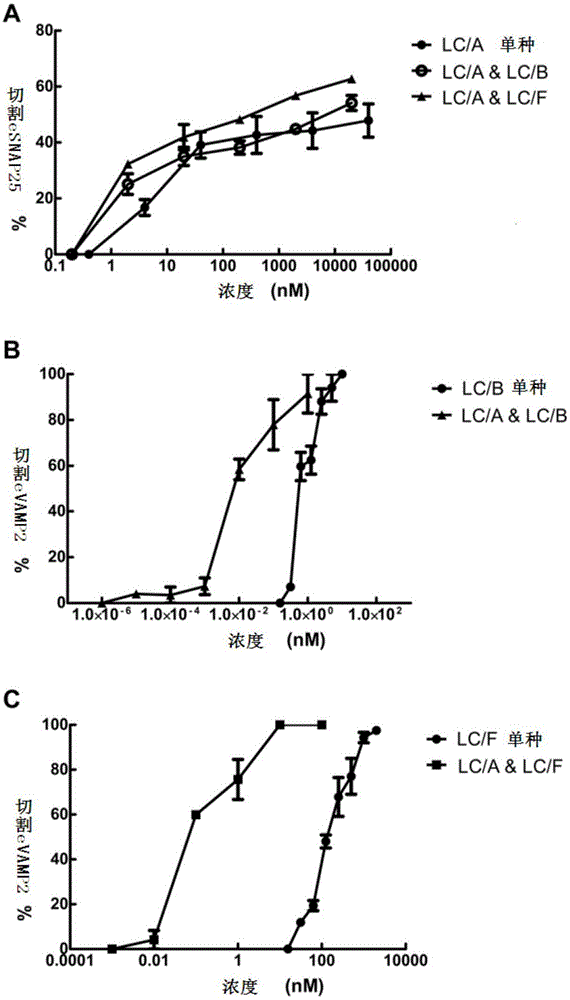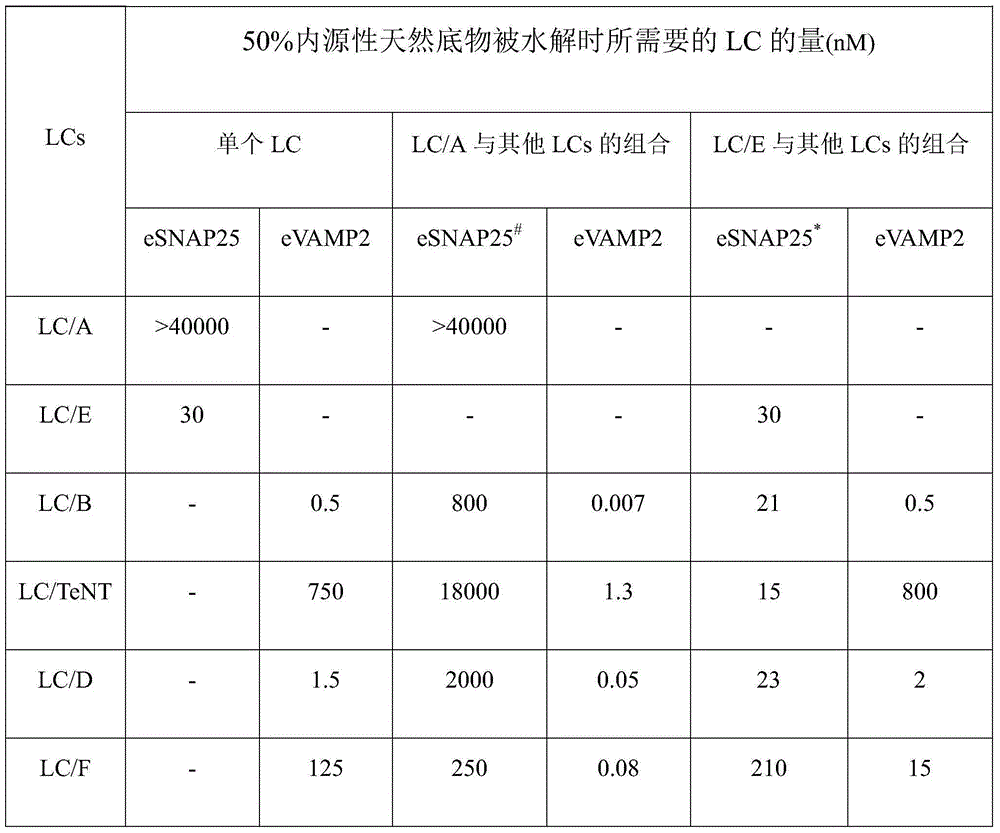Activity combination screening method of botulinum neurotoxin proteins with different subtypes
A botulinum neurotoxin and screening method technology, applied in the field of biotechnology application research, to achieve the effect of improving hydrolysis efficiency
- Summary
- Abstract
- Description
- Claims
- Application Information
AI Technical Summary
Problems solved by technology
Method used
Image
Examples
Embodiment 1
[0039] Example 1 Hydrolysis efficiency of a single botulinum neurotoxin light chain protease on endogenous natural substrates
[0040] First, construct recombinant vectors containing each subtype of botulinum neurotoxin light chain protease genes, express the several botulinum neurotoxin light chain proteases in Escherichia coli in the form of His tag fusion protein, and use Ni-NTA agrose( Invitrogen) affinity media separation and purification to obtain a fusion protein with higher purity and concentration;
[0041] Second, culture Neuro-2A cells (ATCC) according to conventional cell culture methods and following the supplier's recommendations;
[0042] Finally, mix a certain concentration of a single fusion protein with a certain volume of Neuro-2A cell lysate in a 10 μl reaction system (10mM Tris–HCl pH 7.6 and 20mM NaCl), place it in a 37°C constant temperature incubator for 20min, and then add SDS-PAGE sample buffer terminates the reaction.
[0043] The data obtained in ...
Embodiment 2
[0044] Example 2 The hydrolysis efficiency of endogenous natural substrates by combinations of different botulinum neurotoxin light chain proteases
[0045] In order to further analyze whether different combinations of botulinum neurotoxin light chain proteases can affect the hydrolysis efficiency of each light chain protease to its specific endogenous natural substrate, two different botulinum neurotoxin light chain proteases were combined with certain The volume of Neuro-2A cell lysate was mixed in 10 μl reaction system, and the experimental operation in Example 1 was repeated. The combination of botulinum neurotoxin light chain protease follows the following principles: LCs (such as LC / A and LC / E) that specifically hydrolyze SNAP-25 and LCs that specifically hydrolyze VAMP-2 (such as LC / B, LC / D, Combination between LC / F and LC / TeNT), that is, the two LCs in the combination hydrolyze different substrates.
[0046] The results are shown in Table 1. Table 1 shows that the co...
Embodiment 3
[0047] Example 3 The combination of LC / A&LC / B can significantly improve the hydrolysis efficiency of LC / A or LC / B to its specific endogenous natural substrate
[0048] The analysis of Examples 1 and 2 found that under the same standard conditions (i.e. the amount of LC required when 50% of the endogenous natural substrate was hydrolyzed), separate LC / A and LC / B Respectively >40000nM and 0.5nM were required to hydrolyze 50% of the corresponding substrate, but in the combination of the two LCs, this value was reduced to 800nM and 0.007nM, respectively, as shown in Table 1, figure 1 A and figure 1 As shown in B, figure 1 A represents LC / A alone and its hydrolytic activity on endogenous natural substrates exhibited in combinations LC / A&LC / B and LC / A&LC / F, figure 1 B represents the hydrolysis activity of LC / B alone and its combination LC / A&LC / B to endogenous natural substrates. It can be seen from the figure that the activities of LC / A and LC / B were increased by >50 times and ab...
PUM
 Login to View More
Login to View More Abstract
Description
Claims
Application Information
 Login to View More
Login to View More - R&D Engineer
- R&D Manager
- IP Professional
- Industry Leading Data Capabilities
- Powerful AI technology
- Patent DNA Extraction
Browse by: Latest US Patents, China's latest patents, Technical Efficacy Thesaurus, Application Domain, Technology Topic, Popular Technical Reports.
© 2024 PatSnap. All rights reserved.Legal|Privacy policy|Modern Slavery Act Transparency Statement|Sitemap|About US| Contact US: help@patsnap.com









